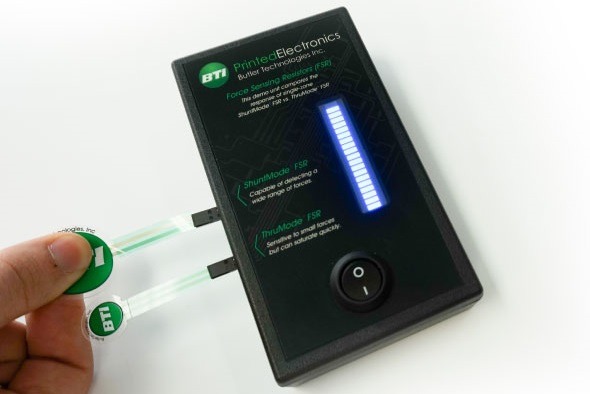Force sensing resistors, commonly known as FSRs, were created back in 1977 with the sole purpose of making electronic musical instruments more expressive. What started out as a product created for strictly one purpose has skyrocketed, opening up thousands of different application opportunities in the process.

What are Force Sensing Resistors?
In simple terms, a force sensing resistor is a material whose resistance changes when a pressure, or force, is applied. Because of this, FSRs are considered a variable resistor. An FSR is constructed with multiple thin, flexible layers all with varying resistances. Their main application is measuring the force applied to a specific area. Once the force is measured, the information is sent through a selected electronic output. Typical applications include musical instrument controllers, augmented reality systems in video games, Dr. Scholl’s insoles, inventory control, and so much more!
How Do They Work?
Force sensing resistors are variable resistors, and as pressure is applied to the sensor, the resistance will lower. As the pressure is removed, the resistance will return to its original value. Generally, the more pressure applied to the sensor’s surface, the lower the resistance will be and the higher the conductance will be. FSRs are made with carbon-based inks, which, when combined with other design factors, can change the functionality as needed for the FSR. There are five layers consisting of the fabric, the base TPU film, conductive silver traces and busbar system, resistive carbon elements, and a final cover film that can be customized with printed graphics.
There are two types of force sensing resistor configurations: ShuntMode™ and ThruMode™. ShuntMode force sensing resistors can detect a wide range of forces whereas ThruMode force sensing resistors are more receptive to lighter forces.

Shunt Mode™ Force Sensing Resistors
ShuntMode force sensing resistors received their name because when the FSR’s two layers are pushed together, the semiconductive FSR element found on the top layer shunts the traces on the layer beneath. ShuntMode force sensing resistors are more receptive to a broader range of forces and are the most frequently used construction. ShuntMode FSRs are commonly constructed with two layers of flexible polymers. The top layer of the ShuntMode FSR is a semiconductive element that is then placed onto a flexible substrate. The bottom layer consists of conductive traces on a flexible substrate and then arranged into two sets of interdigitating fingers.
ShuntMode force sensing resistors can be designed in several different configurations, making them a great option for many different industry applications. Different design features include using different materials, such as silvers, carbon, and blends, or copper. However, silver conductive ink is the most common material for ShuntMode FSRs. They can also be designed with various patterns that can impact the sensitivity levels of the FSR.
 Applications for ShuntMode FSRs:
Applications for ShuntMode FSRs:
- Airbag Occupancy Controls
- Dr. Scholl’s Shoe Insoles
- Hospital Bed Occupancy Detection
- Inventory Control
- Baseball and Golf Swing Assist and Grip Sensors
- Steering Wheel Control Console
ThruMode™ Force Sensing Resistors
ThruMode force sensing resistors get their name from the current passing through the carbon layer to the silver on the opposite side. The more pressure that is applied, the more it allows more current to pass through the carbon layer found between the two silver conductors.
ThruMode force sensing resistors are more receptive to lighter forces and are more linear than ShuntMode FSRs. ThruMode FSRs are also generally constructed with two layers of substrate. On each side of the substrate, a conductive pad is printed. The conductive pads can be made of silver or graphite and silver blended ink. Ink is then printed on top of the conductive pads. These two substrates are placed facing each other and an adhesive can be used to seal the two substrate layers together, thus creating the sensor. However, when the two substrate layers are sealed, the FSR element is placed onto the solid conductive area and fully covers the conductor rather than using interdigitated fingers.
Although they’re less commonly used than ShuntMode FSRs, they are best used for smaller form factors because they’re not limited to the same print constraints as the ShuntMode interdigitated silver fingers. However, ThruMode FSRs are also more costly than ShuntMode because they require more silver and carbon inks.
 Unique Applications for Thru Mode FSRs:
Unique Applications for Thru Mode FSRs:
- Robotic Finger Tips
- Musical Instrument Controllers
- Infusion Pumps
- Augmented Reality Systems (Video Games)
- Target Force and Accuracy Detection
- Cell Phone Stylus